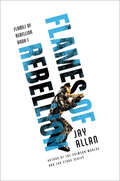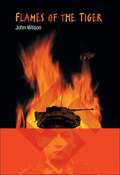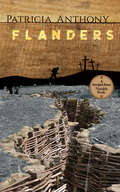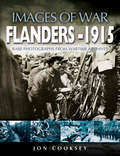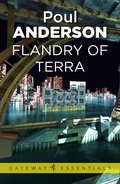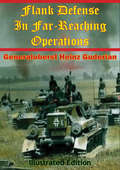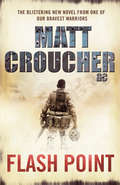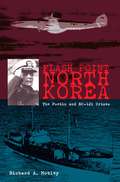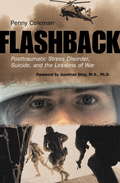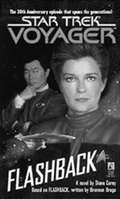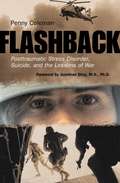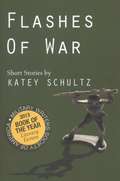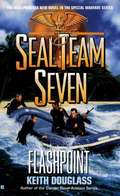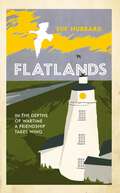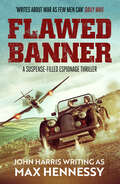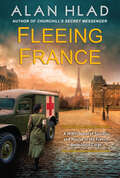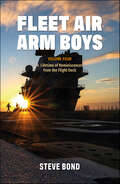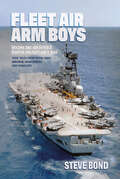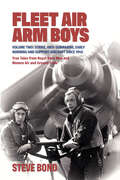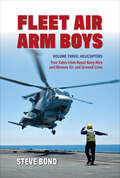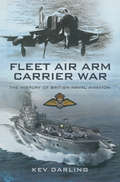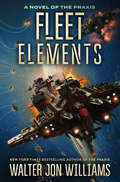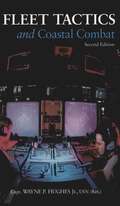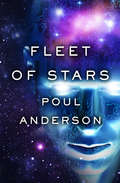- Table View
- List View
Flames of Rebellion
by Jay AllanA group of rebels fighting for independence sows the seeds of revolution across the galaxy in this blockbuster military sci-fi adventure from the author of the Crimson Worlds and Far Stars series.The planet Haven slides closer to revolution against its parent nation, Federal America. Everett Wells, the fair-minded planetary governor, has tried to create a peaceful resolution, but his failure has caused the government to send Asha Stanton, a ruthless federal operative, to quell the insurgency.Wells quickly realizes that Stanton has the true power . . . and two battalions of government security troops—specifically trained to put down unrest—under her control. Unlike Wells, Stanton is prepared to resort to extreme methods to break the back of the gathering rebellion, including unleashing Colonel Robert Semmes, the psychopathic commander of her soldiers, on the Havenites.But the people of Haven have their own ideas. They are not the beaten-down masses of Earth, but men and women with the courage and fortitude to tame a new world.Damian Ward is such a resident of Haven, a retired veteran and decorated war hero, who has watched events on his adopted world with growing apprehension. He sympathizes with the revolutionaries, his friends and neighbors, but he is loath to rebel against the flag he fought to defend. That is, until Stanton’s reign of terror intrudes into his life—and threatens those he knows and loves. Then he does what he must, rallying Haven’s other veterans and leading them to the aid of the revolutionaries.Yet the battle-scarred warrior knows that even if Haven’s freedom fighters defeat the federalists, the rebellion is far from over . . . it’s only just begun.
Flames of the Tiger
by John WilsonIn this novel by John Wilson, Dieter is seduced by the pomp and circumstance of war as a boy growing up during Hitler's rise to power. But as global hostilities intensify, Dieter is called upon to fight for his country in a conflict that he doesn't fully understand. With most of his family dead, Berlin in ruins and the Russian army closing in, Dieter can no longer naively cling to his childhood beliefs. The world he is facing is brutal, dirty and unforgiving, and the most he can hope for is the chance to survive.
Flanders
by Patricia Anthony"A harrowing and beautiful novel, demonstrating — again — that Patricia Anthony is one of our great writers." — Publishers WeeklyIn this gritty look at World War I's trench warfare, a young American sharpshooter ventures into no man's land each night to be ready by daybreak for the grim business of slaying record numbers of enemies. But Travis Lee Stanhope, a Texan serving with an English unit, is haunted by ghosts of the men he's killed as well as those of his fallen comrades. As he hovers on the brink of a transcendent experience, Travis gradually realizes that although he is surrounded by death, his true mission is related to life.A New York Times and American Library Association Notable Book, this tale was acclaimed by Booklist as "a haunting, sometimes almost hallucinatory, yet surprising war novel" and by Kirkus Reviews as "mesmerizing … highly textured and brimming with insight.""Flanders ranks close to All Quiet on the Western Front in its impact." — San Francisco Chronicle"Anthony's subtle and innovative storytelling reaches a new plane in her latest novel, a foray into magical realism that contrasts the waking hell of war with the fragile peace of eternity." — Library Journal
Flanders 1915: Rare Photographs From Wartime Archives (Images of War)
by Jon CookseyBy Christmas 1914 Britain's Regular Army had virtually ceased to exist. Four months of hard fighting had drained its manpower and the Territorial Army were called on to plug the gaps. The part-timers leapt at the chance to serve their country overseas and were soon on their way to the trenches and the harsh realities of war on the Western Front.Flanders 1915 tells the story, through rare and previously unpublished photographs and extended captions, of one of those eager Territorial battalions posted to Flanders during the first twelve months of WW1. It forms a unique and intimate record of the early years of war; many images captured on film by the private cameras of the battalion's junior officers, before official censorship was established. Above all it is a rare and outstanding portrait of the 'great adventure' of war in the days before Loos, the Somme and Passchendaele and the resulting lengthy casualty lists.
Flandry of Terra: A Flandry Book (Gateway Essentials #8)
by Poul AndersonCaptain Sir Dominic Flandry was a top man in the Intelligence Corps of the Imperial Terrestrial Navy. He knew that on the outer edges of the empire, civilisation was spread hideously thin. The stars faded towards barbarism, with the great evil Empire of Merseia beyond.But there were times when Flandry abandoned his senior position of command to go out into the field. Then he operated like the cool and brilliant agent he was, a ruthless, highly-trained professional. And in these three fast-moving adventures Captain Dominic Flandry shows that a space-age secret agent has to stay on top of the job - or succumb to nameless horrors.
Flank Defense In Far-Reaching Operations [Illustrated Edition]
by Generaloberst Heinz GuderianIncludes the World War Two On The Eastern Front (1941-1945) Illustration Pack - 198 photos/illustrations and 46 maps.Often written during imprisonment in Allied War camps by former German officers, with their memories of the World War fresh in their minds, The Foreign Military Studies series offers rare glimpses into the Third Reich. In this study the father of the Panzerarmeen, Generaloberst Heinz Guderian discusses how he and his tanks attained such success in Russia.Focussing on the Second Panzer Army's, which he commanded during 1941, General Guderian discusses the actions for the offensive over the Bug, the crossing of the Dnepr, the attack at Smolensk, the thrust at Kiev, the breakthrough at Orel-Bryansk and the operations around Tula.
Flash Point
by Matt Croucher GCDan Coldrain is a former elite Royal Marine Commando haunted by the death of his best mate Reese, killed in action by enemy forces. Coldrain used to believe in honour, service, and the call of duty, but haunted by Reese's death, he drops out of service and instead seeks the lucrative pay cheques on the private military contractor's circuit.Soon the Sandman, a shadowy figure with connections to the political underworld, lurks into view, with a proposal for Coldrain: find a man called Dogan - a terrorist responsible for a slew of lethal IED attacks in both Iraq and Afghanistan - detain him and hand him over to the Sandman. For this simple task Coldrain will be granted a four-man team, access to high-grade weapons and explosives and vehicles, and a cool £1 million per head once the mission is completed. And so the hunt begins, with the contractors dragged through hell and back in search of their deadly suspect. Will Coldrain and his team complete their mission successfully? And, most importantly, will Coldrain battle the demons which so haunt him over his friend's death?
Flash Point
by Richard Aellenhatred erupted like a volcano Sam saw it coming and yelled her name. Too late. Without hesitation or warning she spit in Tayib's face. There was a gasp, Tayib's features darkened, his hand moved in a blur beneath his robe and emerged with a knife. Sam rushed forward but soldiers wrestled him back. Tracy was shouting, "Get your hands off." Two of the shaheen pinned Katherine's arms. Tayib grabbed her hair, yanked her head back and brought the blade to her throat. "No," Sam yelled. He rammed an elbow into one man's stomach, broke free and threw himself at Tayib. Something smashed the back of his head, jagged pinwheels of light, the room tilted and he was on his hands and knees. A drop of blood glistened and disappeared into the rug. Dead, he thought. We're all dead.
Flash Point North Korea
by Richard MobleyDuring a dark period of U.S. military history in the late 1960s, North Korean forces captured an American naval vessel and shot down an unarmed reconnaissance aircraft, taking the lives of thirty-one U.S. sailors and Marines and striking a damaging blow to American honor. This look back to that earlier time of crisis provides serious food for thought as contemporary strategists again grapple with a North Korean regime that threatens regional security and U.S. national interests. The capture of USS Pueblo has been written about extensively but rarely in context with the shoot down four months later of an EC-121 aircraft and never with so much relevant documentation Richard Mobley, a veteran naval intelligence officer who served on the staff of U.S. forces in Korea during the late 1990s--confronting many of the same challenges faced in the 1960s and today--has uncovered a vast array of recently declassified documents that shed new light on these events and address lingering questions about U.S. reactions and its failure to retaliate. The formerly top secret answers to these and many other frequently asked questions are all covered in Mobley's groundbreaking investigation. His careful examination of the resource strains caused by concurrent U.S. involvement in Vietnam the unexecuted retaliatory plans, and lessons learned confirms many criticisms long leveled at U.S. planners and decision-makers. It also challenges other criticisms by revealing new information and by placing these facts in the context of the time. The author couples the wisdom of hindsight with the revelation of new information for a timely new work on a subject of ongoing and vital importance.
Flashback
by Penny ColemanWith the recent wars in Afghanistan and Iraq, once again America's men and women who have seen war close-up are suddenly expected to return seamlessly to civilian life. In Flashback, Penny Coleman tells the cautionary and timely story of posttraumatic stress disorder in the hope that we can sensitively assist those veterans who return from combat in need of help, and the families struggling to support them.From the Trade Paperback edition.
Flashback (Star Trek )
by Diane CareyA hundred years before the Starship VoyagerTM was transported to the Delta Quadrant, Lieutenant Tuvok served under one of Starfleet's most famous officers: Captain Hikaru Sulu of the Starship ExcelsiorTM. Now those days have come back to haunt him. While traveling through an uncharted nebula, Tuvok is besieged by recurring memories of his time with Captain Sulu -- repressed memories that may well kill him unless their source is determined in time. To save her closest friend, Captain Kathryn Janeway follows Tuvok to the century-old bridge of the Excelsior during a desperate battle. There Tuvok, Captain Janeway, Captain Sulu and Commander Janice Rand must face a menace to galactic life unlike anything known before. . . .
Flashback: Post-Traumatic Stress Disorder, Suicide, and the Lessons of War
by Penny ColemanWith the recent wars in Afghanistan and Iraq, once again America's men and women who have seen war close-up are suddenly expected to return seamlessly to civilian life. In <i>Flashback</i>, Penny Coleman tells the cautionary and timely story of posttraumatic stress disorder in the hope that we can sensitively assist those veterans who return from combat in need of help, and the families struggling to support them.
Flashes of War: Short Stories
by Katey SchultzIlluminating the intimate, human faces of war, this unique series of short stories by award-winning author Katey Schultz questions the stereotypes of modern war by bearing witness to the shared struggles of all who are touched by it. Numerous characters-returning U.S. soldier and pragmatic jihadist, Afghan mother and listless American sister, courageous amputee and a ghost that cannot let go-appear in Flashes of War, which captures personal moments of fear, introspection, confusion, and valor in one collection spanning nations and perspectives.
Flashpoint (Seal Team Seven, #11)
by Keith DouglassAfter a successful mission in Iran, Lieutenant Commander Blake Murdock and his team of Navy SEALs get some new toys to play with. The Bull Pup is the most advanced infantry rifle ever, able to shoot around corners with a range up to a thousand yards. And they've gotten it just in time for a little test run... A corrupt election has given Colombia a new president: the country's second biggest drug lord. The SEAL team is sent in to ruin his business--and take him out. They're the most dangerous drug cops the Colombians have ever seen. And with the Bull Pups, these old dogs are about to learn some new tricks...
Flatlands
by Sue HubbardA moving tale of unlikely friendship and the beauty of nature, set in the wild wetland landscape of the English Fens during World War II Perfect for fans of Atonement, this gorgeous coming of age explores the connection between Philip, a conscientious objector, and Freda, a young London evacuee housed by a cruel familyFreda is a twelve-year-old evacuee from East London, who has been sent away at the start of the war, leaving behind everything familiar to her, to escape the expected German bombing.In her new temporary home in Lincolnshire, Freda finds herself billeted with a strange, cold and, ultimately, abusive couple, whose lives mirror the barren landscape in which they live a hand to mouth existence, based upon subsistence farming and poaching. There, deprived of any warmth, she meets a young man - Philip Rhayader -a conscientious objector who has left Oxford and his prospective vocation in the church following a nervous breakdown.Together they explore the wild, beautiful landscape of the Wash, teeming with migrating birds, and nurse an injured goose back to health. As they do so, Philip introduces Freda to the wonders of the natural world and its enduring power to heal.
Flawed Banner (Shadows of War Collection)
by Max HennessyA desperate hunt for a man who could turn the tide of the Second World War.As the Nazi hordes of Germany overrun France, devouring the free world with fascist fervour, the fate of the Allied resistance looks grim. But things might be about to change.A young intelligence officer, James Woodyatt, is shipped across the Channel to find a First World War hero, an old man who may have been a spy… and who may be in possession of Nazi secrets that could devastate their regime.A scintillating romp through Occupied France from an author with direct experience of combat, perfect for fans of Alistair MacLean, Alexander Fullerton and Jack Higgins.
Fleeing France: A WWII Novel of Sacrifice and Rescue in the French Ambulance Service
by Alan HladInspired by real wartime events, including the evacuation of Dunkirk and the sinking of RMS Lancastria—one of the most harrowing disasters in British maritime history—this is a riveting, superbly researched slice of historical fiction, and a timeless story of strength and sacrifice. Will appeal to fans of Beneath a Scarlet Sky and Eternal.France, 1939: A talented singer, Ruth Lacroix has left Maine to live with her aunt and uncle, dreaming of performing at the Casino de Paris. But with the outbreak of war, and the heartbreaking news that her cousin has been killed by German forces, that goal is supplanted by another—to support France in any way she can. Though Ruth has never driven a vehicle larger than the tractor on her parents&’ farm, she joins a friend in enlisting as a driver for the French ambulance corps. On their way to transfer injured soldiers to Dunkirk for evacuation, they encounter Jimmie, a British Royal Air Force pilot with No. 73 Squadron RAF, who has bailed out of his burning plane. As Dunkirk falls, blocking off the route to the northern coast, word spreads of a daring Allied plan to rescue the remaining troops and civilians from ports in western France: code name Operation Aerial. Over two hazardous weeks, Ruth and Jimmie will journey hundreds of miles together, helping other refugees as they rush to reach the sea before they are overtaken by the Germany army. But all their courage and resilience offer no certainty in wartime, when a single stroke of luck, or a split-second decision, can mean the difference between life and death . . .
Fleet Air Arm Boys: A Lifetime of Reminiscences from the Flight Deck
by Steve BondSteve Bond is back with the final volume in this popular series. Unlike his previous three tomes, with their focus on aircraft and rotorcraft, this book is uniquely dedicated to the personnel of the Fleet Air Arm (FAA) themselves. Each chapter will concentrate on the memories of contributors who served in a range of roles, including those below the flight deck. Accounts will focus on the everyday life upon an aircraft carrier as well as the extraordinary challenges faced during operations. There is a fascinating chapter covering exchange services with the RAF and other navies including the French and US; and also insight into the Indian navy’s experience with the Sea Hawk and Sea Harrier. Within the previous volumes, we met some true characters and there is a chapter devoted to people’s memories of them. The closing section entitled ‘Thoughts’ sees contributors reflect on their FAA career with many deeply moving responses and discourses on the future of the service. The book is heavily illustrated throughout in color and black and white with personal photographs from the contributors, artwork and tongue-in-cheek cartoons for which the FAA is famous. Volume Four is the perfect conclusion to the ongoing post-war story of a truly astounding branch of the armed forces.
Fleet Air Arm Boys: Air Defence Fighter Aircraft Since 1945: True Tales from Royal Navy Aircrew, Maintainers and Handlers
by Steve BondA history of the Royal Navy’s FAA since 1945, featuring a survey of the aircraft flown, the conflicts fought, and the daily life of those in service.The RAF’s continuing role in the projection of air power in the defence of the United Kingdom and its overseas interests since the end of the Second World War is well known. However, the same cannot always be said about the Royal Navy’s Fleet Air Arm (FAA), in part due to the ten-year gap between the retirement of the Harrier and the arrival of the F-35B and the Queen Elizabeth-class aircraft carriers.Flying high performance aircraft off a carrier demands not only a high level of skill, but also a considerable amount of courage and determination, not least to land back on a very small piece of real estate bobbing about in a rough sea, often at night, with no possibility of diversion. The nature of these operations has meant that the accident rate and aircrew losses were very high—and accepted as part of the job.With the arrival of the Queen Elizabeth and the Prince of Wales, it is time to redress the balance and bring the FAA’s extraordinary story to the audience it so richly deserves through the words of those air and ground crews who have been part of it since 1945. What emerges is an amazing close-knit esprit de corps, often accompanied by a long-standing and still simmering rivalry between the RAF and the Royal Navy over who should project air power overseas. Enormous respect is shown by the aviators and ships’ senior officers for the aircraft handlers and maintainers, who work long hours in a highly dangerous environment on the flight deck.This first volume looks chronologically at every aircraft type flown in an air defence role since 1945. Involvement in conflicts including Korea, Suez, the Falklands, Bosnia and elsewhere is included, and perforce the cost in human lives, even in everyday operations, frequently emerges. Balancing this are the everyday grind, the good times, the humour, the “runs ashore” and the sense of pride in a job well done. All delivered in the words of the men themselves.
Fleet Air Arm Boys: Strike, Anti-Submarine, Early Warning and Support Aircraft since 1945
by Steve BondSince the end of World War 2 the primary role of the Royal Navy’s Fleet Air Arm has been airborne power projection; the ability rapidly to respond to any trouble spot across the globe and to protect the interests of the United Kingdom and its partner nations. The principal tools in that response were the strike aircraft which took the offensive to the aggressor. Although from 2010 to 2020 fixed-wing carrier aviation was not part of the Fleet Air Arm, with the advent of the navy’s two new aircraft carriers, HMS Queen Elizabeth and HMS Prince of Wales, that capability has been restored. This renewed focus has not only seen the return of flying high performance aircraft from a carrier, but also the regeneration of the necessary skills, and courage, needed to cope with the extremes of weather and the nature of air operations in a very high-risk environment. However the lessons of the past have not been forgotten, and so many of those previous experiences are related within these pages – true stories of the last 76 years from aircrew, maintainers, aircraft handlers and many other supporting staff both men and women. Following on from the success of volume one, this second volume covers every fixed-wing aircraft type flown from carriers in the strike, anti-submarine warfare and the vital airborne early warning roles; from Scimitars to Hunters, Buccaneers to Skyraiders and many more, plus an extensive fleet of land-based aircraft. As with the first volume, involvement in operations such as Suez, the Beira Patrol, the Falklands, Belize, Bosnia and elsewhere is included. Despite the intensity and all-to-frequent tragedy of operations, the esprit de corps, and the ability to find the necessary release through laughter, shine through. Here are the words of the man and women themselves, profusely illustrated in black and white and color.
Fleet Air Arm Boys: True Tales from Royal Navy Men and Women Air and Ground Crew
by Steve BondHelicopters have been going to sea with the Royal Navy’s Fleet Air Arm for over 70 years. Initially used for search and rescue (SAR) duties from aircraft carriers, the rapid development of both the helicopters and service experience resulted in them taking on the vital anti-submarine (and later anti-ship) attack roles. The 1956 Suez campaign saw the first operational use of Whirlwind helicopters for the insertion of troops by air into a battle zone, a capability which was expanded with more helicopters such as the Wessex, Sea King and today’s Merlin. Through their vital role in the 1960s Indonesian Confrontation, the Commando helicopter force became universally referred to as the ‘Junglies’. It is often said that if either of the 1982 Task Force aircraft carriers had been lost the Falklands War could not have been won. The same would surely have been true without helicopters. Their vital tasks, including inserting Special Forces behind enemy lines, protecting the Task Force from Exocet missile attack and recovering wounded troops whilst under enemy fire, are rightly hailed as being instrumental. At home, the essential SAR effort by both the Royal Navy and their RAF counterparts has resulted in incredible stories of saving lives against the odds. Royal Navy destroyers and frigates have also long since benefitted from having their own helicopter Flight aboard. Frequently operating in extremes of weather, flying a Wasp, Lynx or today’s Wildcat from and back to a heaving deck is every bit as risky as flying fixed-wing aircraft off the carriers of old. Once dismissed as a novelty, the helicopter has more than proved itself. Indeed, for ten years until the arrival of the Queen Elizabeth-class aircraft carriers, the Fleet Air Arm’s operational force was entirely rotary-wing. Today’s Merlins and Wildcats, with their dedicated aircrew, maintenance and support staff continue to demonstrate just how vital an asset the helicopter has become. Here are the words of the men and women themselves, skillfully brought to life by Steve Bond and profusely illustrated in color and b/w.
Fleet Air Arm Carrier War: The History of British Naval Aviation
by Kev DarlingThis is the story of British naval flying from aircraft carriers, from its conception in World War One to the present day. It includes the types of aircraft and the men who flew them, the carriers and the evolution of their designs, the theatres of war in which they served and their notable achievements and tragedies. It traces navy flying from the early days of the biplane, through the rapid developments during World War Two to the post-war introduction of jet-powered flight. The British inventions of the angled flight deck and later vertical landing jets revolutionised sea warfare and allowed the carrier to play a vital part in many recent land wars when naval aircraft flew in support of Allied land forces.Although the British carriers have always been smaller than their American counterparts, the Royal Navy and its aircraft have always been in the van of the development of ships and aircraft. This is the proud history of British Naval flying and ships such as HMS Eagle, HMS Hermes, HMS Glorious, HMS Ark Royal and many more.
Fleet Elements (A Novel of the Praxis #2)
by Walter Jon Williams"Space opera the way it ought to be . . . Bujold and Weber, bend the knee; interstellar adventure has a new king, and his name is Walter Jon Williams."—George R. R. MartinFollowing The Accidental War, the second book of a brand-new series set in the Praxis—an epic mix of space opera and military science fiction, from a grand master of science fiction, Walter Jon Williams.The Praxis, the empire of now extinct Shaa, has again fallen into civil war, with desperate and outnumbered humans battling several alien species for survival. Leading the human forces are star-crossed lovers Gareth Martinez and Caroline Sula, who must find a way to overcome their own thorny personal history to defeat the aliens and assure humanity’s survival.But even if the human fleet is victorious, the divisions fracturing the empire may be too wide to repair, as battles between politicians, the military, and fanatics who want to kill every alien threaten to further tear the empire apart. While Martinez and Sula believe they have the talent and tactics to defeat an overwhelming enemy, what will prevent their fellow humans from destroying themselves?
Fleet Tactics and Coastal Combat
by Wayne P. HughesThis major revision updates Wayne Hughes's 1986 landmark study that is credited with providing decision makers a sound foundation for battle planning and tactical thinking. The book integrates the historical evolution of tactics, analysis, and fleet operations, and today it can serve as a primer for anyone who wants to learn how navies fight and win. This second edition includes much new material on combat in the missile age and reflects the reconfiguration of many tactics for littoral operations after the fall of the Soviet Union.Hughes recreates famous battles to show how tactics have changed through the ages and the ways in which they have remained unchanged. He covers tactical interaction between land and sea, the sensory revolution of WWII, secret weapons and maritime surprise, the role in battle of leadership and morale, and the importance of surface warships in today's U.S. fleet. He suggests that naval tactics, unlike ground combat, are dominated by the offense and concludes that the great tactical maxim must be attack effectively first.A new chapter traces the evolution of missile tactics at sea and includes details of attacks on ships. Many changes emphasize joint operations and coastal combat. The already extensive appraisal of command and control and information warfare is further expanded to cover modern naval operations and the character of modern salvo warfare. In the tradition of Mahan and Clauswitz, this classic text incorporates literature, politics, and a knowledge of human nature. Indispensable reading for all those interested in naval tactics, it is also a valuable reference for wargamers
Fleet of Stars (Harvest of Stars #4)
by Poul AndersonThe multiple Hugo and Nebula Award–winning Grand Master of Science Fiction delivers “an exciting culmination to an ambitious saga” (Publishers Weekly). Far into the reaches of space, Anson Guthrie and a band of colonists have forged a new existence on Amaterasu not as physical beings but as downloaded consciousness watched over by the benevolent Life Mother. Yet as idyllic as their lives may be, back home on Earth the situation is growing grim. Earth’s inhabitants are now completely dependent—and so controlled—by an intelligent machine known as the Teramind. But the instinctual human desire to be free is not something the Teramind has included in its calculations. The seeds of rebellion are growing. Suspecting a conspiracy to suppress humankind’s last vestiges of freedom, Guthrie and his loyal companions make a dangerous journey back to Earth—risking everything to preserve humanity’s independent destiny. The thrilling conclusion to Anderson’s four-volume, award-winning epic vision of mankind’s evolution, begun in Harvest of Stars, “Fleet of Stars is a grand story that gets bigger and better with every page” (Larry Bond).
